For those of you who read this blog, which may only be me at this point, I've decided to jot down some of my best cheap food eating experiences. As Danielle and I are tightening up our outflow of cash we've been re-seeking out cheap food that makes no sacrifice for quality.
http://cheaperthanfood.blogspot.com/
Thursday, November 29, 2007
Tuesday, October 2, 2007
Italy
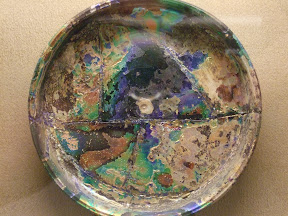 After over a year of debating Danielle and I finally decided to take a vacation in Italy this fall. For two weeks in September we walked, trained, bused, ate, and drank our way across Italy. We've tried to chronicle a few of the highlights here. For those of you with patience we've cataloged over 500 pictures on the linked web album. Just click on the picture above (or any of the ones below) to browse.
After over a year of debating Danielle and I finally decided to take a vacation in Italy this fall. For two weeks in September we walked, trained, bused, ate, and drank our way across Italy. We've tried to chronicle a few of the highlights here. For those of you with patience we've cataloged over 500 pictures on the linked web album. Just click on the picture above (or any of the ones below) to browse.
Rome
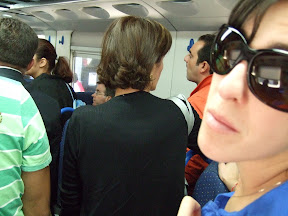 After five hours to Newark, eight hours to Rome, and 30 min. to Termini train station we arrived in the heart of Rome.
After five hours to Newark, eight hours to Rome, and 30 min. to Termini train station we arrived in the heart of Rome.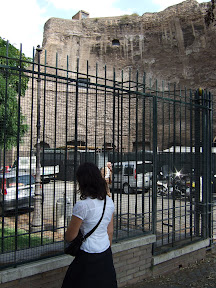 The most dramatic parts of our trip centered around ancient Roman ruins. A surprising byproduct of a society that has lived in the same location for thousands of years is the scattering of ruins across Rome. Close to 200 yards from the train station Danielle had already begun her quest to see every remnant of ancient Roman civilization in Italy. This undescribed ruin was part of the Baths of Diocletion and capped off our 26 hours of continuous walking, interrupted only by seven hours of sleep over the next two days.
The most dramatic parts of our trip centered around ancient Roman ruins. A surprising byproduct of a society that has lived in the same location for thousands of years is the scattering of ruins across Rome. Close to 200 yards from the train station Danielle had already begun her quest to see every remnant of ancient Roman civilization in Italy. This undescribed ruin was part of the Baths of Diocletion and capped off our 26 hours of continuous walking, interrupted only by seven hours of sleep over the next two days.Though tired we decided to make the most of the day and tried to get
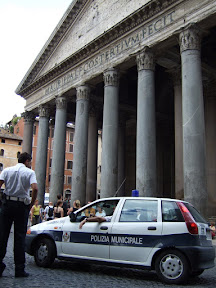 on an Italian time schedule. A short metro ride from Termini (two blocks from our pension) and quick walk through the heart of central Rome's shopping district brought us to the Pantheon, another wonderful example of the integration of ancient ruins in a bustling metropolis and probably, visually, the most impressive ruin within Rome outside of the Colesseum.
on an Italian time schedule. A short metro ride from Termini (two blocks from our pension) and quick walk through the heart of central Rome's shopping district brought us to the Pantheon, another wonderful example of the integration of ancient ruins in a bustling metropolis and probably, visually, the most impressive ruin within Rome outside of the Colesseum. 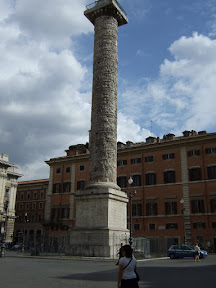 This picture was taken as I sat for a quick break while Danielle was getting cash from a nearby ATM. It was not long into the day that we decided the 14 hour trip had taken more out of us than we had anticipated.
This picture was taken as I sat for a quick break while Danielle was getting cash from a nearby ATM. It was not long into the day that we decided the 14 hour trip had taken more out of us than we had anticipated.Around 5pm we decided to walk back to the hotel for a quick nap. We woke up the next morning. After a quick espresso and brioche the next morning we headed out for the big sites.

After spending ~$15 on bottled water over the first 24 hours we were happy to find one of the many public fountains near the Colosseum. Fortunately the water surging through the all public fountains throughout Rome is potable. This fountain consisted of a steel pipe protruding from a concrete wall draining into an ancient marble sarcophagus. While we were good about keeping hydrated we did not have the foresight to properly care for our feet. This picture began the second day of the 26 hour marathon that resulted in ~9 blisters between the two of us.
 Palatine Hill was the first ruins of the day. Rome was founded here. As we got there early in the day we had the site practically to ourselves. We wandered among the ruins for a few hours enjoying a few quiet moments away from the buzzing of the scooters on the
Palatine Hill was the first ruins of the day. Rome was founded here. As we got there early in the day we had the site practically to ourselves. We wandered among the ruins for a few hours enjoying a few quiet moments away from the buzzing of the scooters on the 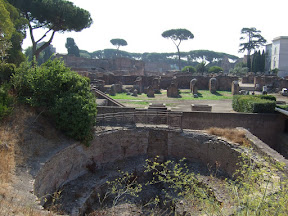 streets before heading over to the Colosseum in the afternoon.
streets before heading over to the Colosseum in the afternoon.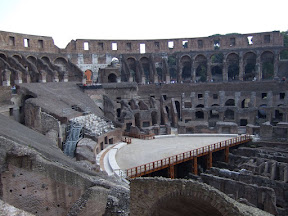 We were fortunate to bypass the throngs of tourists outside the Colosseum, and the English dudes claiming to give you entry and tour for a discount, as our Palatine Hill pass granted access to the site for no extra charge. Outside of Pompeii and Herculaneum this had to be the most spectacular ruin of the trip. After purchasing the audio guide we climbed up the steps to come out on the upper level o
We were fortunate to bypass the throngs of tourists outside the Colosseum, and the English dudes claiming to give you entry and tour for a discount, as our Palatine Hill pass granted access to the site for no extra charge. Outside of Pompeii and Herculaneum this had to be the most spectacular ruin of the trip. After purchasing the audio guide we climbed up the steps to come out on the upper level o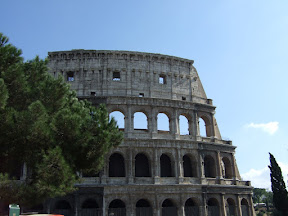 f what once was the greatest theater in the Roman Empire. The audio tours were excellent, but Danielle could not get enough.
f what once was the greatest theater in the Roman Empire. The audio tours were excellent, but Danielle could not get enough. 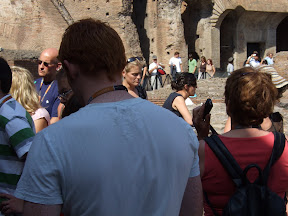 Lucky for her she was able to eaves drop on a few of the English language tours and learn a few more esoteric details about the structure, its construction and use in ancient times. It was pretty cool. By this point I realized that I was in for a sweaty trip. Italy was hot. Maybe 80s every day. After a quick sandwich we concluded the ancient ruins of Rome in the Forum.
Lucky for her she was able to eaves drop on a few of the English language tours and learn a few more esoteric details about the structure, its construction and use in ancient times. It was pretty cool. By this point I realized that I was in for a sweaty trip. Italy was hot. Maybe 80s every day. After a quick sandwich we concluded the ancient ruins of Rome in the Forum. The Roman Forum that is frequented by tourists (and the only part we went to) is only part of what was the original heart of the Roman government and marketplace.
The Roman Forum that is frequented by tourists (and the only part we went to) is only part of what was the original heart of the Roman government and marketplace. 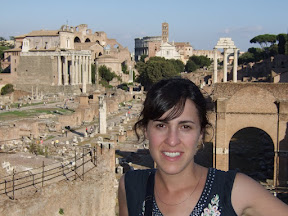 Mussolini paved over much of what was the forum effectively destroying a few buildings and splitting the remaining ruins in two by one of Rome's major streets. Nevertheless, the remaining ruins are spectacular.
Mussolini paved over much of what was the forum effectively destroying a few buildings and splitting the remaining ruins in two by one of Rome's major streets. Nevertheless, the remaining ruins are spectacular.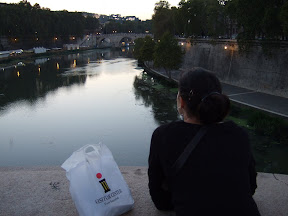 By the time we had fully explored the Forum it was 6-7PM. We decided to walk SE to cross the Tiber river and eat in Trastevere. On the way, we walked through the area of Rome where all of the Jewish people lived during ancient times called the "Jewish Ghetto" in all the guide books. There is still a small Jewish community here and when we walked through the little center square a number of kids were playing kick ball. It felt like Italy in the 1930s. At the end of the night, we picked up a few first aid supplies during a quick pit stop at one of the dozens of pharmacies that we passed after dinner.
By the time we had fully explored the Forum it was 6-7PM. We decided to walk SE to cross the Tiber river and eat in Trastevere. On the way, we walked through the area of Rome where all of the Jewish people lived during ancient times called the "Jewish Ghetto" in all the guide books. There is still a small Jewish community here and when we walked through the little center square a number of kids were playing kick ball. It felt like Italy in the 1930s. At the end of the night, we picked up a few first aid supplies during a quick pit stop at one of the dozens of pharmacies that we passed after dinner. 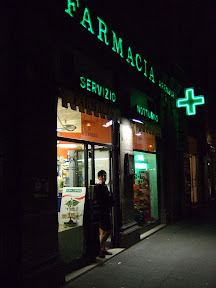 We still had 13 days of walking ahead of us and were not off to a good start.
We still had 13 days of walking ahead of us and were not off to a good start.Since this was our "last" night in Rome we decided to stop by the Pantheon one last time on our way to Trevi fountain and then head back to the hotel.
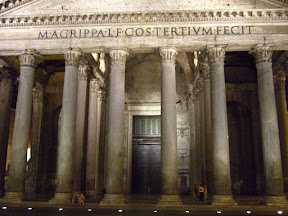 We were both surprised that the Pantheon was even more spectacular at night, surrounded by people enjoying the warm evening. We each threw the obligate coin into Trevi fountain (Danielle was embarrased to do so even though there were about 20 other tourists there doing the exact same thing) after finishing a cup of gelato.
We were both surprised that the Pantheon was even more spectacular at night, surrounded by people enjoying the warm evening. We each threw the obligate coin into Trevi fountain (Danielle was embarrased to do so even though there were about 20 other tourists there doing the exact same thing) after finishing a cup of gelato. 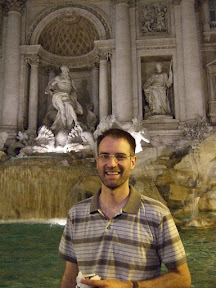 This is supposed to guarantee our return to Rome (I hope the night prior to our flight out didn't count).
This is supposed to guarantee our return to Rome (I hope the night prior to our flight out didn't count).Naples

 We woke up early the next morning and and went to one of Rome's archeology museums prior to our 10AM departure time to Naples. We had arranged for one nights stay and planned to see Pompeii and then make the 6 hour train ride to Siena. We ended up loving Naples and stayed for an additional two nights.
We woke up early the next morning and and went to one of Rome's archeology museums prior to our 10AM departure time to Naples. We had arranged for one nights stay and planned to see Pompeii and then make the 6 hour train ride to Siena. We ended up loving Naples and stayed for an additional two nights. 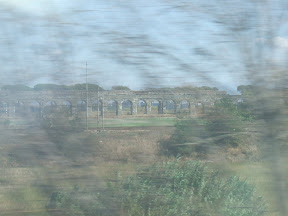 On the train ride south we caught glimpses of the ancient Roman aqueducts that provided the running water supply for the Roman people and the fountains.
On the train ride south we caught glimpses of the ancient Roman aqueducts that provided the running water supply for the Roman people and the fountains.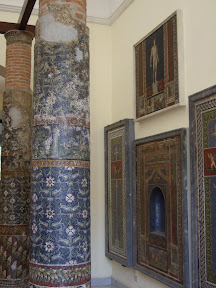 Our first stop was the National Archeological Museum which houses the most magnificent frescos and mosaics from both Pompeii and Herculaneum. Dozens of representative mosaics and red painted stucco walls were on display.
Our first stop was the National Archeological Museum which houses the most magnificent frescos and mosaics from both Pompeii and Herculaneum. Dozens of representative mosaics and red painted stucco walls were on display.  It was actually nice for us to be able to see these mosaics up close because most of the wall mosaics in Pompeii are out of reach. A scaled model gave the first preview of the magnitude of the ruins of Pompeii.
It was actually nice for us to be able to see these mosaics up close because most of the wall mosaics in Pompeii are out of reach. A scaled model gave the first preview of the magnitude of the ruins of Pompeii. 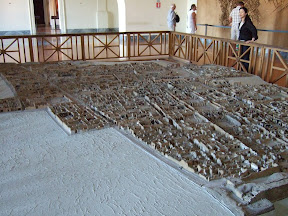 The model was made in the 1800's (they started excavating Pompeii in the 1700! Some of the murals and houses found in this model from the 1800s have already been lost. Up until seeing this model I had never realized the sheer magnitude of the ruins.
The model was made in the 1800's (they started excavating Pompeii in the 1700! Some of the murals and houses found in this model from the 1800s have already been lost. Up until seeing this model I had never realized the sheer magnitude of the ruins.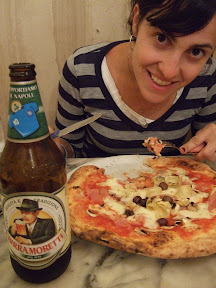 We ate pizza that night. Naples is the birthplace of pizza. With that in mind we searched for a pizza place that would best represent the Neapolitan pizza experience.
We ate pizza that night. Naples is the birthplace of pizza. With that in mind we searched for a pizza place that would best represent the Neapolitan pizza experience. 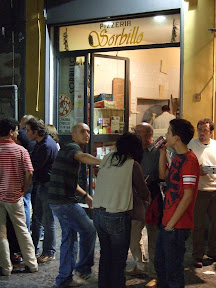 All of our books pointed us toward Sorbillo's. The grandfather of the current owner of Sorbillo's pizza is said to have invented the calzone and has past his family secrets down through the generations. The restaurant was a quite four table operation with one server and about 10 diners, a mix of locals and tourists, at any given time. We were tired from training and walking all day, but the pizza was fantastic. There is nothing quite like hot wood-fired pizza in a city where it was actually invented. We would later learn that the true Sorbillo's was about 2 doors down. Who knows who the guy was who was running this one. We still came back the next night.
All of our books pointed us toward Sorbillo's. The grandfather of the current owner of Sorbillo's pizza is said to have invented the calzone and has past his family secrets down through the generations. The restaurant was a quite four table operation with one server and about 10 diners, a mix of locals and tourists, at any given time. We were tired from training and walking all day, but the pizza was fantastic. There is nothing quite like hot wood-fired pizza in a city where it was actually invented. We would later learn that the true Sorbillo's was about 2 doors down. Who knows who the guy was who was running this one. We still came back the next night.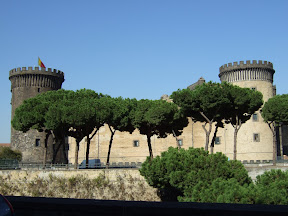 We had to leave our hotel - a room in a building from the 1400s where some of the rooms had the original frescos on the wall-because it was pricey and we only reserved the room for one night. So we checked into a hostel run by a Neopolitan guy who, perhaps because we were a bit older and less interested in partying, gave us an hour lecture about all of the wonderful sites in the city that we needed to see (he smoked about 2 packs of cigarettes during the lecture and meticulously used 6 different color highlighters to map out a rout for us around Naples). We then set off to do him proud. We also walked down to the waterfront to see Castel Nuovo and Palazzo Reale.
We had to leave our hotel - a room in a building from the 1400s where some of the rooms had the original frescos on the wall-because it was pricey and we only reserved the room for one night. So we checked into a hostel run by a Neopolitan guy who, perhaps because we were a bit older and less interested in partying, gave us an hour lecture about all of the wonderful sites in the city that we needed to see (he smoked about 2 packs of cigarettes during the lecture and meticulously used 6 different color highlighters to map out a rout for us around Naples). We then set off to do him proud. We also walked down to the waterfront to see Castel Nuovo and Palazzo Reale.  This was the first of the palaces that we visited during our two week trip. It was everything you would expect from an ancient palace of Italian royalty. Filled with opulent decor, vaulted and painted ceilings, a beautiful garden in the back overlooking the Bay of Naples it did not disappoint.
This was the first of the palaces that we visited during our two week trip. It was everything you would expect from an ancient palace of Italian royalty. Filled with opulent decor, vaulted and painted ceilings, a beautiful garden in the back overlooking the Bay of Naples it did not disappoint. On the way back to the hotel we stopped in to one of the oldest cafes in Naples for an espresso and sfogliatelle.
On the way back to the hotel we stopped in to one of the oldest cafes in Naples for an espresso and sfogliatelle. 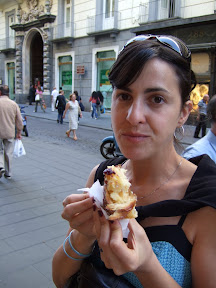 Sfogliatelle is a Neapolitan pastry which consists of layers of crispy, flaky dough usually filled with sweetened ricotta cheese. It sounds pretty bad, but was actually quite good. A little shell shopping brought us back to the hotel.
Sfogliatelle is a Neapolitan pastry which consists of layers of crispy, flaky dough usually filled with sweetened ricotta cheese. It sounds pretty bad, but was actually quite good. A little shell shopping brought us back to the hotel.
Pompeii
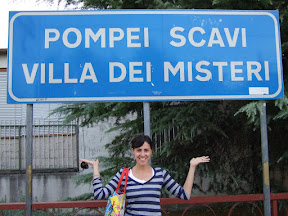
The next morning after bandaging up our feet we boarded the Circumvesuviana train which circumnavigates Mt. Vesuvius and connects the small towns in the Bay of Naples including Pompeii.
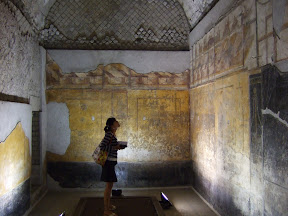
Immediately upon entering Pompeii it is hard not to be impressed with the size of the city. Blocks upon blocks of buildings are intact and preserved as though only build 100 years ago. Floors are covered by
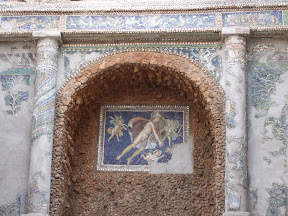 geometric mosaics and abut walls with brilliant pastel frescoes illustrating scenes from ancient Roman life. The various public baths were some of the best preserved ruins that we saw during the entire trip still containing most of the original mosaic art present when buried two thousa
geometric mosaics and abut walls with brilliant pastel frescoes illustrating scenes from ancient Roman life. The various public baths were some of the best preserved ruins that we saw during the entire trip still containing most of the original mosaic art present when buried two thousa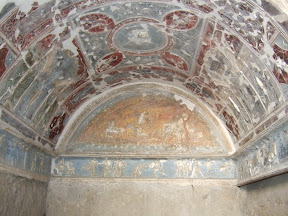 nd years ago. Many of the frescoes surrounding the walls of house courtyards appeared as vivid today as they must have been in the past.
nd years ago. Many of the frescoes surrounding the walls of house courtyards appeared as vivid today as they must have been in the past.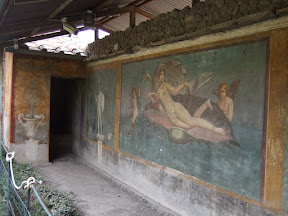
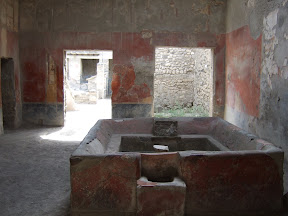 The picture shown on the left served as one of the old laundry buildings of Pompeii.
The picture shown on the left served as one of the old laundry buildings of Pompeii.The square basin was used to wash clothes with hot water. Through the door pictured on the left was a courtyard where they where wet clothes were hung out to dry. Despite it functioning as a business it was as brilliantly decorated as many of the other houses.
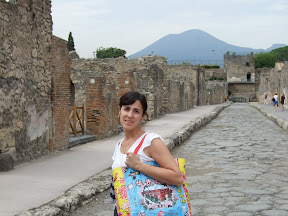 The city of Pompeii was laid out in blocks with streets delineating each block. Sidewalks on the side of the street allowed foot traffic while the stone paved roads allowed animal, wheeled vehicles, and sewage/rain passageway. These stepping stones cut across each of the four sides of an intersection allowing pedestrians to c
The city of Pompeii was laid out in blocks with streets delineating each block. Sidewalks on the side of the street allowed foot traffic while the stone paved roads allowed animal, wheeled vehicles, and sewage/rain passageway. These stepping stones cut across each of the four sides of an intersection allowing pedestrians to c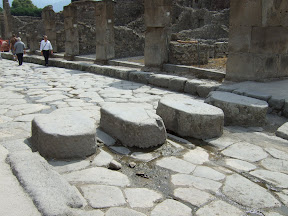 ross the street without soiling their feet. Grooves in the pavement attest to the carriages or wheels passing over the stones over hundreds of years. Vesuvius is visible from most parts of the city, a constant reminder of the reason Pompeii exists today.
ross the street without soiling their feet. Grooves in the pavement attest to the carriages or wheels passing over the stones over hundreds of years. Vesuvius is visible from most parts of the city, a constant reminder of the reason Pompeii exists today.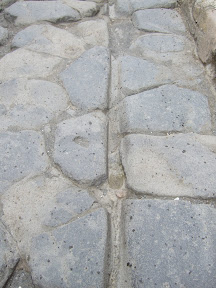 The final bath that we walked through
The final bath that we walked through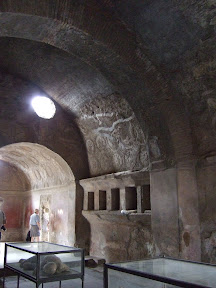 contained the only plaster cast of a few of the victims of Pompeii. There are dozens of others, but the city is so large we were unable to find them. All for the better. It was pretty spooky to see the facial expressions and contorted bodies of these guys at the end of their life.
contained the only plaster cast of a few of the victims of Pompeii. There are dozens of others, but the city is so large we were unable to find them. All for the better. It was pretty spooky to see the facial expressions and contorted bodies of these guys at the end of their life.
Herculaneum
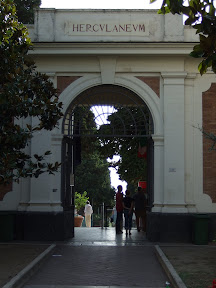
 After a good 6 hours wandering the streets of Pompeii we decided to move on to Herculaneum. Fortunately we had taped up the feet well enough to endure another couple of hours of walking. Just few train stops closer to Naples (and Mt Vesuvius) lies Herculaneum, the vacation spot for former dwellers of the bay of Naples. We arrived toward the end of the day and by the time we purchased tickets the site was only open for about 2 more hours.
After a good 6 hours wandering the streets of Pompeii we decided to move on to Herculaneum. Fortunately we had taped up the feet well enough to endure another couple of hours of walking. Just few train stops closer to Naples (and Mt Vesuvius) lies Herculaneum, the vacation spot for former dwellers of the bay of Naples. We arrived toward the end of the day and by the time we purchased tickets the site was only open for about 2 more hours. 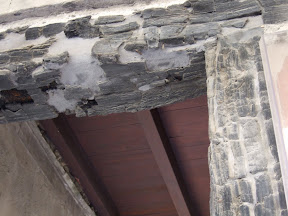 Compared to Pompeii, Herculaneum is considered a much better preserved set of ruins due to its closer proximity to the volcano. Many of the second and third stories of the ancient businesses and houses have been preserved. Occasionally one can see some of the original wood used during construction of the buildings thousands of years
Compared to Pompeii, Herculaneum is considered a much better preserved set of ruins due to its closer proximity to the volcano. Many of the second and third stories of the ancient businesses and houses have been preserved. Occasionally one can see some of the original wood used during construction of the buildings thousands of years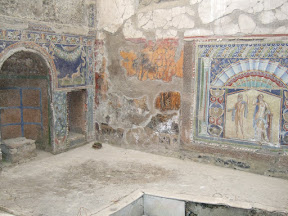 ago that was instantly carbonized from the heat of the volcanic eruption. Some of the best mosaics and frescos of the site are not roped off or under restoration like they are in Pompeii. Unfortunately, much of the original city still lies buried underground. The current city of Herculaneum has been built on top of the old preventing any further excavation.
ago that was instantly carbonized from the heat of the volcanic eruption. Some of the best mosaics and frescos of the site are not roped off or under restoration like they are in Pompeii. Unfortunately, much of the original city still lies buried underground. The current city of Herculaneum has been built on top of the old preventing any further excavation.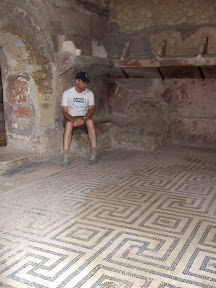
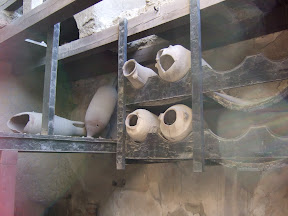 Again, the baths held many of the best preserved mosaics and original building materials in the entire site. One particularly cool building was an old wine/food shop. Carbonized original wood shelving still holding what were once storage containers for food and wine. A small staircase led from the bottom of this shop to the living quarters upstairs.
Again, the baths held many of the best preserved mosaics and original building materials in the entire site. One particularly cool building was an old wine/food shop. Carbonized original wood shelving still holding what were once storage containers for food and wine. A small staircase led from the bottom of this shop to the living quarters upstairs.Siena

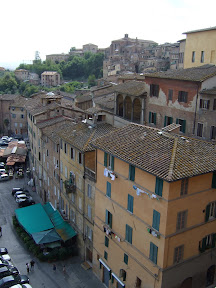 After a long day of Herculaneum and Pompeii we returned to our hotel in Naples for a good nights sleep. The next morning, after a dose of espresso, we hopped the train to Siena. About 5 hours later we landed in what was one of our favorite towns of the trip...and not just because one of Bob Ross' favorite paint colors, Burnt Siena, is named after the brownish-red rooftops of this town.
After a long day of Herculaneum and Pompeii we returned to our hotel in Naples for a good nights sleep. The next morning, after a dose of espresso, we hopped the train to Siena. About 5 hours later we landed in what was one of our favorite towns of the trip...and not just because one of Bob Ross' favorite paint colors, Burnt Siena, is named after the brownish-red rooftops of this town.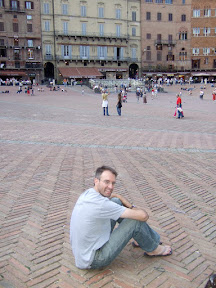 It seems a bit cliche given that every tourist that has been here loves it, but it is hard to find anything unattractive about the city.
It seems a bit cliche given that every tourist that has been here loves it, but it is hard to find anything unattractive about the city.The social heart of Siena, particularly for tourists like us, is Il Campo, or the central plaza. It is shaped like a three dimensional scallop shell rising and fanning out from the Palazzo Publico (town hall). During all hours of the day every day people gather here to socialize, sit, eat, and just relax. According to Wikipedia, Il Campo is "regarded as one of the most beautiful civic spaces in Europe." I have to agree that it was one of our favorite places to relax during the entire trip.
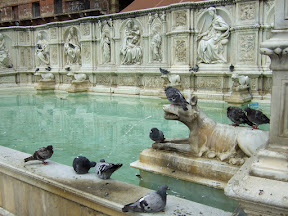 The scallop shaped plaza is divided up into nine sections each one representing an original neighborhood in the historic old center. These represent nine of the 17 or so neighborhoods that compete in the Palio (an annual bareback horse riding competition that takes place in the plaza twice a year). At the far end of Il Campo, near where I'm sitting above, is the plaza's fountain - Fonte Gaia. The "Fountain of Happiness" depicts stories of the bible. Marble panels here are replicas (we would later see the originals in the city's museum). Unfortunately, the fountain has been gated off from people and now is primarily ruled by pigeons. If you look closely at the picture on the left you'll see an unlucky pigeon floating in the distance.
The scallop shaped plaza is divided up into nine sections each one representing an original neighborhood in the historic old center. These represent nine of the 17 or so neighborhoods that compete in the Palio (an annual bareback horse riding competition that takes place in the plaza twice a year). At the far end of Il Campo, near where I'm sitting above, is the plaza's fountain - Fonte Gaia. The "Fountain of Happiness" depicts stories of the bible. Marble panels here are replicas (we would later see the originals in the city's museum). Unfortunately, the fountain has been gated off from people and now is primarily ruled by pigeons. If you look closely at the picture on the left you'll see an unlucky pigeon floating in the distance.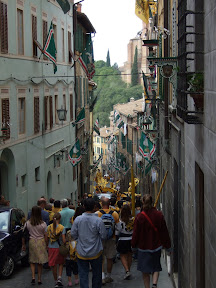 The winner of the Palio competition is granted bragging rights until the next race (usually a year away). Bragging consists of parading through the town with your colors playing music and talking trash. We were lucky enough to stumble across one such parade during our second day in town on our way to see the Duomo (cathedral).
The winner of the Palio competition is granted bragging rights until the next race (usually a year away). Bragging consists of parading through the town with your colors playing music and talking trash. We were lucky enough to stumble across one such parade during our second day in town on our way to see the Duomo (cathedral).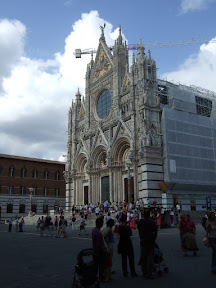 The Duomo in Siena bears a striking resemblance to that of Florence. Built in Tuscan Gothic style it is a bit of an eyesore albeit an ornate and kind of pretty one. The interior of the cathedral however differs from that of Florence dramatically. The people of Siena insisted that it be grander than the Florence
The Duomo in Siena bears a striking resemblance to that of Florence. Built in Tuscan Gothic style it is a bit of an eyesore albeit an ornate and kind of pretty one. The interior of the cathedral however differs from that of Florence dramatically. The people of Siena insisted that it be grander than the Florence 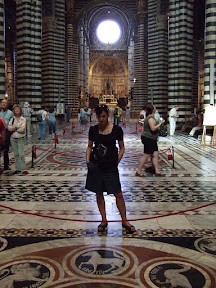 Duomo during the years when the two cities were fighting to be the renaissance capital of Italy. Lavish inlaid marble floors and statues by Michaelangelo and Donatello adorn the entire layout. There were even plans to expand the cathedral until the plague hit the city.
Duomo during the years when the two cities were fighting to be the renaissance capital of Italy. Lavish inlaid marble floors and statues by Michaelangelo and Donatello adorn the entire layout. There were even plans to expand the cathedral until the plague hit the city.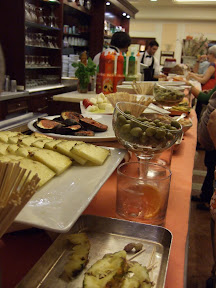 Siena was where Danielle discovered that most bars in northern Italy offer free appetizers to anyone who buys a cocktail. Most places would set their goods out around 5PM meaning that by 5:15 we would be in there mowing down "dinner."
Siena was where Danielle discovered that most bars in northern Italy offer free appetizers to anyone who buys a cocktail. Most places would set their goods out around 5PM meaning that by 5:15 we would be in there mowing down "dinner."  I was impressed with Danielle's knack for stacking piles of olives, bread, cheese, fruit onto a cocktail napkin. Gelato was a highlight here, as it was just about everywhere else. Unfortunately, this is only one of a couple of pictures documenting the experience. If its good enough for Gods followers its good enough for me.
I was impressed with Danielle's knack for stacking piles of olives, bread, cheese, fruit onto a cocktail napkin. Gelato was a highlight here, as it was just about everywhere else. Unfortunately, this is only one of a couple of pictures documenting the experience. If its good enough for Gods followers its good enough for me. 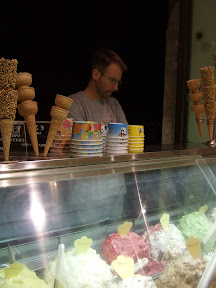 Favorite flavors: pistachio, lemon, watermelon, and rice.
Favorite flavors: pistachio, lemon, watermelon, and rice.
Subscribe to:
Posts (Atom)